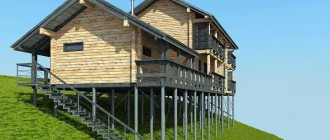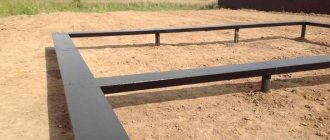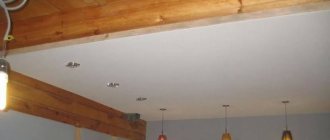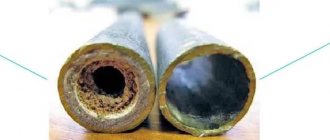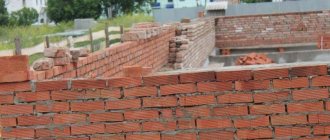It is difficult for a non-specialist to know which foundation to choose for a house. Traditional strip and slab laying is not used in all cases - there are a number of restrictions. In addition, they are quite expensive, which is not always justified economically.
A pile foundation with a grillage will require less investment, therefore, if conditions permit, it is more profitable to use it.
It seems that this is a house “on legs” Source sampochinil.ru
What is a grillage type pile foundation?
Such a foundation is a structure of piles buried in the ground below the freezing depth of the soil, and connected at the top using a metal or concrete strip (grillage). The supports can be combined by one common slab located at ground level or slightly above. The structure, built in accordance with all the rules, is reliable and has a long service life - several decades.
Concrete grillage Source domsdelat.ru
Here you can clearly see what a foundation grillage is - this is the entire upper part of any pile foundation, which is also called the “cap”. The purpose of the grillage is to evenly distribute the load from the load-bearing elements of the structure onto the piles and, accordingly, onto the ground.
There are several types of grillage:
- Made. It consists of separate elements, which are a structure of three piles reinforced with a welded frame. To install them, you will need a crane.
Prefabricated grillage from beams Source orchardo.ru
- Monolithic reinforced concrete. It is a solid plate or strip. Poured directly at the construction site.
Monolithic cast reinforced concrete grillage Source 24stroim-dom.by
- Prefabricated monolithic. An intermediate option, made from prefabricated parts, which in turn are assembled in a factory, and are already cemented in place using locks and key connections.
Waterproofing technology
The grillage is waterproofed using one of the most common materials:
- Hot bitumen.
- Bitumen mastic.
- Pasting with roofing felt.
- Application of impregnating compounds.
The simplest and fastest option is to use bitumen mastic, which performs its tasks perfectly and is sold in ready-to-use form. Apply by roller or brush, usually in one or two coats.
Advantages and disadvantages of a pile-grillage foundation
Each of the listed types of foundation has advantages and disadvantages that are taken into account during design in order to prevent excessive consumption of materials, deformations and cracks in supporting structures. Among the most common types of foundation, designers have a choice between strip, slab, pile-grillage and pile. If we compare the pros and cons of a pile-grillage foundation with other types of foundations, then SRF wins in many ways.
In fact, the advantages of a pile-grillage foundation far outweigh the disadvantages Source lowcarb-ernaehrung.info
The properties of a foundation with a grillage determine the following advantages of its use:
- applicable for any soil, including mobile and unstable, water-saturated or peaty;
- convenient when building a house in an area with uneven terrain (for example, on a slope);
- does not require large consumption of materials;
- has a significant service life;
- installation is slightly dependent on weather conditions - work is allowed at air temperatures down to -10°C;
- It is stable and has good load-bearing capacity.
On water-saturated soils, building a foundation requires special skill and accurate calculations Source termeszetvedelem.hu
Cons:
- there are restrictions related to bearing capacity: the foundation is used only for one- and two-story buildings;
- construction of a basement or basement is possible, but involves complex and costly design solutions;
- installation requires high precision, so it is strongly recommended to entrust it to specialists;
- installation work requires the use of special equipment.
Its required height
The height of the grillage is directly related to the material of the walls of the house. If you plan to build a brick (concrete, cinder block) house, then the minimum height is considered to be 15-20 cm above ground level. For wooden houses, the height of the grillage should be slightly increased and be about 40-60 cm .
This will provide the necessary flexural rigidity and will allow the wood to be separated from sources of moisture below.
This refers to the snow cover, the height of which must also be taken into account. If the region has very snowy winters with high snowdrifts, it is necessary to calculate the height of the grillage to exceed their level.
Types of pile-grillage foundations according to the method of immersion in the ground
- Driven. The supports are driven into the ground using construction equipment.
- Printed. It involves drilling wells, which are subsequently filled with concrete.
- Screw. It is a method of screwing in piles using special equipment.
A special expense item is the use of special equipment Source blog-potolok.ru
See also: Catalog of companies that specialize in foundation repair and design.
Types of piles used
Depending on the method of immersion, piles are selected:
- Hammers. For them, wells are prepared in advance, with a depth of 1/3 of the height of the pile. For installation, special construction equipment is used: pressing machine, vibratory hammer, vibratory hammer. Wooden, steel, reinforced concrete and hollow supports are used as driven supports.
Reinforced concrete piles: if the installation technology is followed, the supports will last for many decades Source block-gbi.ru
- Bored. Formwork and reinforcement are placed in the well for strength, then filled with concrete.
- Drilling. Wells are drilled in advance, into which reinforced concrete supports are then installed.
- Screw. They are hollow pipes, at the bottom of which there are blades and a pointed tip. The supports are screwed into the ground using special equipment.
UBM-85 for driving screw piles Source stroy-dom-pravilno.ru
Piles can have a rectangular or circular cross-section. The materials used for them are concrete, reinforced concrete, steel of various grades, and mostly coniferous wood. Of the tree species, larch is considered the most suitable, containing a large amount of resins that protect the piles from rotting.
Driven metal piles are one of the cheapest and most durable Source blog-potolok.ru
Classification by depth
Depending on the position relative to the ground, there are 3 types of grillage:
- Low or recessed. Its peculiarity is that it is installed below ground level, that is, in the ground. The grillage is placed on a sand cushion.
- Ground. Located at surface level.
- Tall or hanging. It is located above ground level on high supports. If groundwater flows close to the surface, this type of grillage is used.
Recessed grillage Source nauka-i-religia.ru
Recessed grillages are used only in cases of extreme necessity, since their installation is comparable in complexity to installing a shallow strip foundation: it is necessary to dig a pit, arrange a drainage sand cushion, make formwork, but also install piles.
Unlike buried and above-ground grillages, hanging grillages are not as labor-intensive and, as a result, less expensive.
Laying depth - what it depends on
The depth of placement depends on the condition of the soil on the site.
All related factors are taken into account:
- Groundwater level.
- Availability and volumes of soil water.
- Possibility of flooding in spring.
- The presence of seasonal changes in hydrogeology, an increase or decrease in the degree of filling of all aquifers.
To select the correct depth, it is often necessary to collect information from local geological and meteorological departments, consult with experienced builders, and refer to various SNiP applications.
It must be taken into account that all values indicated in various sources are minimum, i.e. it is allowed to increase the lifting height, but it is impossible to reduce the gap height .
Stages of installation of a pile foundation with a grillage
The equipment of a pile-grillage foundation is divided into the preparatory stage and the installation itself. At each stage you have to perform several types of work:
Preliminary work
- To build a foundation, you first need a project , which is created on the basis of calculations of loads, the expected depth of immersion of piles, and what materials the foundation is planned from.
A project from a professional is a guarantee of safety, long service life, as well as savings in materials and finances Source nl.decorexpro.com
- Then the area is prepared : debris, topsoil and plant roots are removed.
- The territory is : the location of supports, grillage, load-bearing structures of partitions is noted.
Attention! Deviation from the project is always the cause of negative consequences, such as curvature of the foundation, the occurrence of unforeseen expenses, and more. Therefore, it is important that the project is drawn up by professionals and is tied to the area.
The work of a “professional” is immediately visible Source blog-potolok.ru
- A trench is dug for the grillage. Its walls and bottom are checked for evenness with a level. After this, a sand cushion is laid and compacted.
- Wells are drilled for supports , at the bottom of which a sand cushion is also placed. Waterproofing is placed in the pit: you can use a special film, several layers of roofing felt, or plastic pipes.
Technology for installing a pile-grillage foundation
- For the grillage, reinforced concrete beams are used or a monolithic tape is poured. A wooden rectangular formwork is prepared for it, which is secured with supports and lintels. At this stage it is also worth taking care of the sewerage and pipeline.
Photo of a pile-grillage foundation - after the concrete has dried, the formwork is removed Source bestroof.ru
- To increase the strength of the structure, a reinforced frame is placed in the well - 4 metal rods tied with wire. Then the concrete is poured. The tape is also reinforced.
- Next, concrete is poured first into the wells, then into the formwork. The concrete will take at least 10 days to set, after which the formwork will be dismantled.
How is the need for foundation materials calculated?
An accurate calculation can only be performed by a specialist - a civil engineer, who will rely on the requirements of SNiP and a number of indicators such as the strength of supports, grillage, bearing capacity of the foundation, soil resistance force, degree of shrinkage of the support under the influence of vertical load, etc. The specialist will determine the depth of immersion of the supports, their diameter, number, type of grillage and develop a diagram.
For a person without specialized education, calculations for a pile-grillage foundation look something like this Source ask.fm
When calculating the number of supports, they are based primarily on the load on the foundation, which consists of several indicators. Here it is necessary to know the mass of load-bearing walls, partitions, roofs, floor slabs, i.e. the entire mass of the building above the foundation. The payload produced by residents, household items and all other things is also taken into account. In calculations for private houses, an indicator of 150 kg/m² is used.
The last parameter for determining the total load is the weight of the snow mass that can accumulate on the roof in winter. The value generally used is 180 kg/m², but for a number of regions of the country it is slightly different. The resulting sum of loads is multiplied by the safety factor, which is 1.1 (sometimes 1.2 is used). Next, you can calculate the load on one pile.
It would not be out of place to add that online calculators for calculating materials that are widespread on the Internet should be treated very carefully. They may not take into account a number of important parameters.
Installing additional items
When constructing a pile-grillage foundation, it is necessary to arrange openings for ventilation in the foundation and lay pipes that can be used for heating, sewer, water supply systems and other communications. If you do not take care of the engineering and technical equipment of the house in time, later to install them you will have to partially destroy the grillage.
To preserve the foundation, it is imperative to provide vents for ventilation Source remontstroy.net
Requirements for creating a high-quality grillage foundation
Since the main loads on the grillage are bending forces, one of the key points when creating a grillage foundation is reinforcement, which significantly increases the strength of the structure.
Reinforcement diagram Source stroidominvest.ru
The second significant point concerns the hardening time of the concrete structure - which is a whole month. The grillage will be able to withstand the proper loads only after the concrete has completely hardened.
Construction of the basement.
After the pile monolithic foundation is built, we proceed to finishing the base. The upper edge of the basement trim is attached to the bottom of the house and is protected from above by a special galvanized canopy (shimmer). From below, the finishing does not reach the ground by several centimeters. This is done so that during soil heaving the base is not subject to deformation. To remove precipitation, drainage is installed, and a concrete blind area about 70 cm wide is made. The best solution for a blind area around the entire perimeter of the house is paving slabs. It is durable, aesthetic and repairable.
Possible mistakes when arranging the foundation
- The piles are not firmly attached to the grillage - thermal expansion during seasonal temperature fluctuations will soon loosen the fastening point.
- The piles are laid at too shallow a depth. Here, both excessive shrinkage of the foundation and squeezing out of loose piles in the layer below the freezing of the ground by forces of soil heaving cannot be ruled out. All this can lead to the destruction of the building.
- Inaccurate calculations. It's just a powder keg - you never know what might happen.
Insulation scheme
Waterproof materials are used for insulation:
- Liquid polyurethane foam.
- Extruded polystyrene foam (penoplex).
- Styrofoam.
- Expanded clay.
- Foam glass, etc.
The most convenient and effective option is considered to be penoplex, which is glued in a dense layer to the entire surface of the grillage, both internal and external.
It is somewhat worse, but much cheaper, to use polystyrene foam , which is also resistant to moisture and is an excellent heat insulator, but has the ability to crumble and is excessively brittle.
